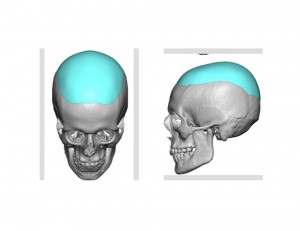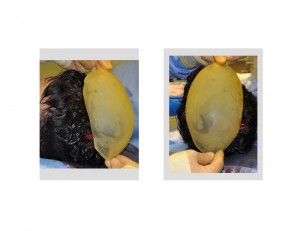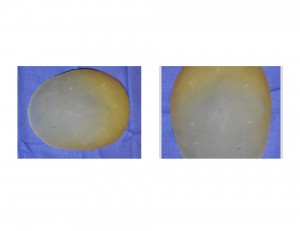Background: The shape of the human skull has many variations beyond just being an overall oblong shape. Besides the smoothness of its surface, it has width, height and length dimensions that give it an overall perception of head size. If these skull dimensions are not proportionate, this can make the head seem too small or too big in how it relates to the face that lies below it.
But the skull can also have shape considerations along with any dimensional issues. One such shape and size skull concern is that of the smaller head that appears not tall enough. In essence, this is a lack of skull or cranial height often accompanied by a normal lack of convexity between the temporal lines. This may extend from the forehead to the vertex but often goes around to the back as well.
Case Study: This 21 year-old male wanted a taller and more rounded skull. He felt his head was flat across the top. He hid his concerns abut his head shape by styling his hair upward across the top which he could do quite well with his thick and curly dark hair. But despite this camouflage effort, he was not satisfied as he wanted to wear his hair short and find a permanent solution to his skull shape concern.



A custom skull cap implant is the only known method for creating increased skull height and a more convex shape. It is the only way to guarantee a precise fit, smooth shape and feather edging around its entire perimeter. There are limits to the height through its thickness that can be achieved and that is how much the scalp will stretch underneath it. A safe thickness is 10mm or less. Bit with such a large surface area of the implant, a little thickness goes a long way in changing the skull shape. A scalp closure that is not unduly tight is important given the broad avascular surface of the implant underneath.
The use of custom skull implants continues to grow and expand and its use above the face represents another example of its growing role in aesthetic craniofacial surgery.
Case Highlights:
1) Deficiency of upper skull height or convexity of shape can be improved by a custom skull cap implant.
2) Because of the broad surface area of a skull cap implant, one must be careful to not make it too thick to allow for a scalp closure that it not under considerable tension.
3) Due to the flexibility of the silicone material, a skull cap implant can be inserted through an incision that is smaller in length than the implant’s width.
Dr. Barry Eppley
Indianapolis, Indiana




